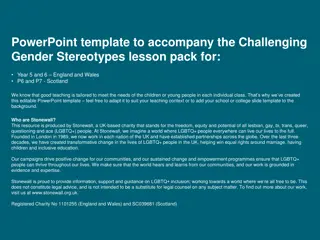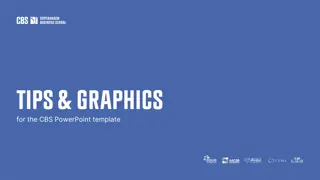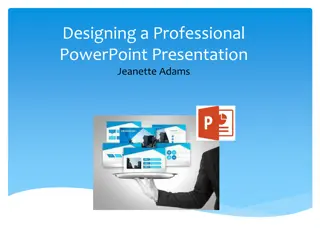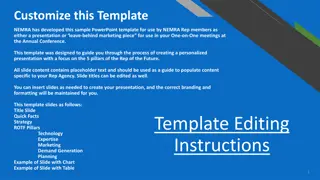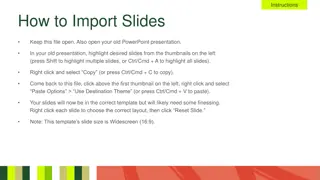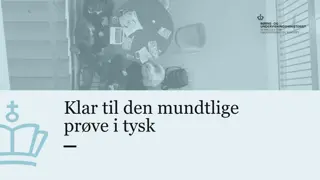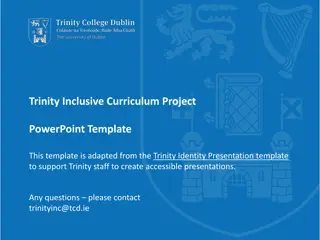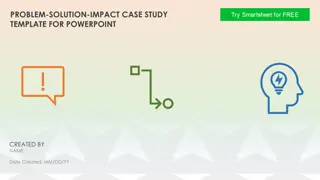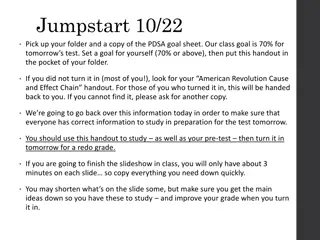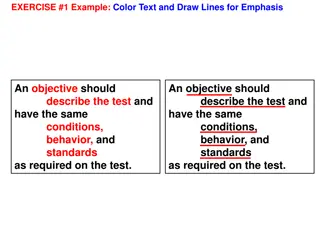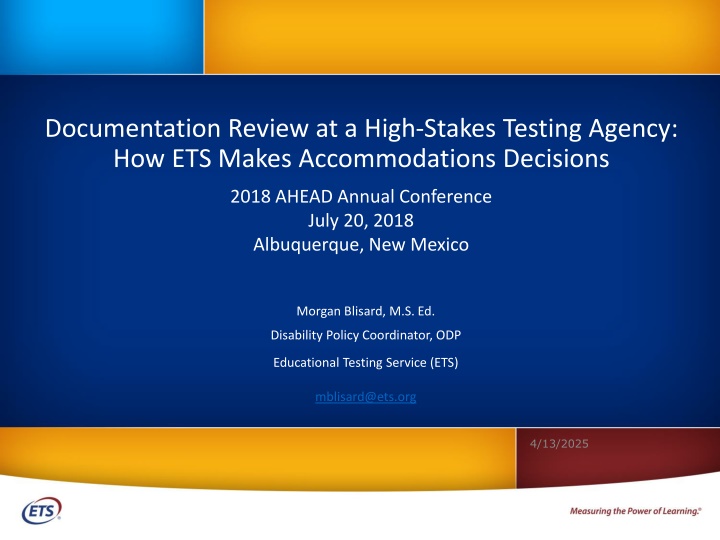
Making Accommodations Decisions at High-Stakes Testing Agencies
Learn how ETS reviews documentation for accommodations decisions and the key factors considered in the process. Understand why disability documentation is crucial and get insights into differing accommodations between postsecondary institutions and testing agencies. Discover tips and guidelines for submitting documentation effectively.
Download Presentation

Please find below an Image/Link to download the presentation.
The content on the website is provided AS IS for your information and personal use only. It may not be sold, licensed, or shared on other websites without obtaining consent from the author. If you encounter any issues during the download, it is possible that the publisher has removed the file from their server.
You are allowed to download the files provided on this website for personal or commercial use, subject to the condition that they are used lawfully. All files are the property of their respective owners.
The content on the website is provided AS IS for your information and personal use only. It may not be sold, licensed, or shared on other websites without obtaining consent from the author.
E N D
Presentation Transcript
Documentation Review at a High-Stakes Testing Agency: How ETS Makes Accommodations Decisions 2018 AHEAD Annual Conference July 20, 2018 Albuquerque, New Mexico Morgan Blisard, M.S. Ed. Disability Policy Coordinator, ODP Educational Testing Service (ETS) mblisard@ets.org 4/13/2025
Agenda Introduction to ETS Accommodations Review Process Certification of Eligibility (COE): Accommodations History form Reviewing Documentation 10 Guiding Questions Why Disability Documentation May Be Insufficient Differing Accommodations: Postsecondary vs. Testing Agencies Suggestions and Recommendations Additional Tips Supplemental Information 2
Whos Who at ETS Office of Disability Policy (Research & Development) Sets policies and procedures Internal & External Reviewers Performs initial review of applications 37 expert panel reviewers Disability Services Call center and processing General Counsel s Office Responds to legal complaints 3
Accommodations Review Process Completed registration form & fee Part I (Applicant Information) Part II (Testing Accommodations Request) Part III (Certification of Eligibility: Accommodations History), if applicable Documentation should only be submitted if it is required 4
Certification of Eligibility (COE): Accommodations History form Expanded COE includes ASD, TBI, physical, and psychiatric disabilities for 50% extended test time and extra breaks The documentation on file at the post-secondary institution must align with ETS documentation guidelines, including recency requirements Documentation for medical disabilities/chronic health conditions and other still requires review due to the episodic/transitory nature of these disabilities 5
When Documentation is Needed Documentation should only be submitted if it is required What do we generally look for in the documentation? Focus is on current functional limitations Historical information is very important Past use of accommodations Evidence of impact the disability has on academic performance Supported rationale for each request Guidelines for documenting specific disability categories is available on our website (www.ets.org/disabilities) 6
10 Guiding Questions When Reviewing Documentation 1. Does the test taker s evaluator clearly indicate a disability that is covered under the ADA AA? There can be flexibility if functional limitations are very clear 2. Does the test taker s evaluator appear to be qualified to make the diagnosis? 3. Is the documentation current as per ETS guidelines? For example, ADHD 5 years; psychiatric disabilities 1 year 4. Does the documentation include relevant history (e.g., educational, developmental, medical, social and/or occupational)? 7
10 Guiding Questions When Reviewing Documentation, Cont d 5. Does the documentation include a list of administered tests with standard scores of all subtests administered? This is only relevant to certain disabilities/accommodation requests 6. Is the documentation sufficient to support the stated disability? Does it go beyond a DSM-5 diagnosis? 7. Is there evidence of the functional limitations and current impact of the disability in the documentation as it pertains to taking this test? There should be a clear link between the documentation and requested accommodations 8
10 Guiding Questions When Reviewing Documentation, Cont d 8. Is there sufficient explanation in the documentation to support the need for each of the requested accommodations? 9. Is there a documented recent history of using accommodations? Example: Post-secondary setting, workplace or prior standardized tests 10. If no accommodations were given previously, is there a detailed rationale for why accommodations are needed now? Example: Student diagnosed in grade school with LD but did not use accommodations on SAT or in college 9
Reasons Why ETS May Deem Documentation Insufficient Accommodations recommended by the evaluator are based on preferences rather than disability-driven reasons Specifically, the documentation fails to show the impact of the disability on a major life activity There is an insufficient description of history of a disability (e.g., childhood through college) and how it relates to current problems with academic performance or employment The documentation is considered outdated per the applicable guidelines available at www.ets.org/disabilities; therefore, current functional limitations and impact on academic/test-taking performance is unclear Documentation may be primarily based on an IEP or 504 Plan from high school. Scores may be missing from the report. The impact of the disorder appears to be more a relative weakness than a disability that is substantially limiting. 10
Differing Accommodations: Postsecondary vs. Testing Agencies Reduced distraction testing environment with few people vs. separate room Extended test time vs. extra stop the clock breaks Medical/episodic conditions The accommodation requested presents a test construct issue The requested accommodation would fundamentally alter what the test is meant to measure Example: Request for a reduction of answer choices, use of formula card, or permission to use a scientific calculator 11
Additional Tips Prometric (computer-based testing centers) offers test takers the opportunity to experience the testing environment prior to their scheduled testing appointment. For a fee, test takers can take a 30- minute "test drive" of the test center experience, including walking through the check-in procedures that will occur on test day. Certain personal items can be taken into the Prometric test center, such as, earplugs (foam with no strings attached), eye drops, ice packs, inhaler, small pillow for lumbar support, etc. Full list of pre-approved personal items can be found on our website at www.ets.org/disabilities. Test takers should be aware of accommodations that are only available for computer-based tests vs. paper-based tests Test takers are encourage to familiarize themselves with the test they will be taking (e.g., if a calculator is already available on the computer screen) 12
Supplemental Information We always welcome test takers to provide additional sources of information to support their disability documentation, such as, personal statements and letters of support from their DS provider Generally we ask that the personal statement describe the nature of the test taker s disability, current/past use of accommodations and why the requested accommodations are needed for the upcoming test Guidance for how to compose a personal statement is available on the website at www.ets.org/disabilities. Letters of support from DS service providers describing the accommodation utilized and attesting to the effectiveness of the accommodations may be helpful Tips for Disability Service Providers is available on our website (www.ets.org/disabilities) 13

